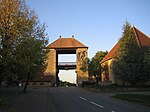In the First Battle of Wissembourg (13 October 1793) an Allied army commanded by Dagobert Sigmund von Wurmser attacked the French Army of the Rhine under Jean Pascal Carlenc. After an ineffectual resistance, the French army abandoned its fortified line behind the Lauter River and retreated toward Strasbourg in confusion. This engagement of the War of the First Coalition occurred on the eastern border of France about 60 kilometres (37 mi) north of Strasbourg.
After the siege of Mainz in which the Prussian army captured the city, the Army of the Rhine fell back into the Lines of Weissenburg, a position first fortified in 1706. Soon Wurmser with an army composed of troops from Habsburg monarchy, French Royalists and allied German states began putting pressure on the Lines. Meanwhile, the French army organization was in disarray after two previous army commanders were arrested and sent to Paris prisons. Since no one wanted to lead the army, the representatives on mission appointed Carlenc, recently a lieutenant colonel of cavalry. After a series of skirmishes, Wurmser launched a successful assault. After the French retreat, the inept Carlenc was arrested and replaced in army command by Jean-Charles Pichegru. At the urging of the government, Pichegru began launching a series of attacks designed to recover the lost territory. These resulted in the battles of Froeschwiller and Second Wissembourg.










